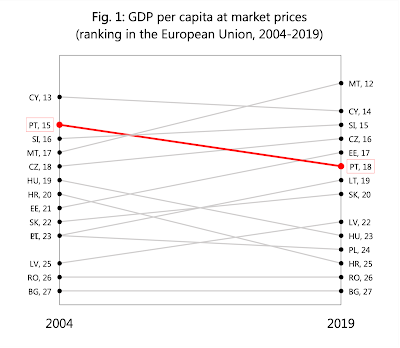Portugal Elections: Results and alternative systems
Last January's Portuguese elections were interesting on two accounts: a) the Socialist Party won an outright majority against all odds; and b) it did so with an exceptionally high concentration of seats per vote. While I don't dismiss the importance of the first one, people more capable than me have already discussed it at length. So, I wanted to concentrate on the second one for a change.
A bit of background: Portuguese legislative elections have electoral circles at the district level, the most important first-level administrative subdivisions in continental Portugal. On top of that, there are also 4 other circles: the Azores, Madeira (both autonomous regions), the European, and the Outside of Europe circles. The number of seats assigned to each district (and region) depends on its magnitude (population-wise). The European and Outside of Europe circles elect a fixed number of 2 MPs each. District MPs are elected using a proportional system, namely the d'Hondt method. The d'Hondt method makes for a higher effective threshold than other allocation methods such as the Hare quota or Sainte-Laguë method, which are more generous to small parties.
| Government | Vote Share | Seats | Seats (%)/ Votes (%) | |||
| (%) | # | (%) | ||||
| Cavaco (III) | 50.6 | 135 | 58.7 | 1.16 | ||
| Guterres (I) | 43.8 | 112 | 48.7 | 1.11 | ||
| Guterres (II) | 44.1 | 115 | 50.0 | 1.13 | ||
| Sócrates (I) | 45.0 | 121 | 52.6 | 1.17 | ||
| Costa (III) | 41.5 | 119 | 51.7 | 1.25 | ||
Out of curiosity, I decided to forecast the seats assigned to each party using significantly more proportional methods (only showing the parties that would have seats assigned by any of the methods). The first column is the number of seats each party would get under the technique. The second column would be the ratio between the seats and votes shares. And the third column would be the change relative to the d'Hondt method, our current standard.
Besides the Sainte-Laguë method, I also calculated using a genuinely proportional system by district and a proportional system using just one circle (i.e., assigning seats based on the total votes received).
| Party | d'Hondt | Sainte-Laguë | Proportional (District) | Proportional (one circle) | |||||||||
| PS | 119 | 1.25 | 107 | 1.12 | -12 | 101 | 1.06 | -18 | 98 | 1.03 | -21 | ||
| PSD | 78 | 1.16 | 74 | 1.10 | -4 | 72 | 1.07 | -6 | 69 | 1.03 | -9 | ||
| Chega | 12 | 0.72 | 15 | 0.90 | 3 | 21 | 1.25 | 9 | 17 | 1.02 | 5 | ||
| IL | 8 | 0.71 | 10 | 0.89 | 2 | 10 | 0.89 | 2 | 12 | 1.07 | 4 | ||
| CDU | 6 | 0.59 | 9 | 0.89 | 3 | 11 | 1.08 | 5 | 10 | 0.98 | 4 | ||
| BE | 5 | 0.51 | 9 | 0.91 | 4 | 9 | 0.91 | 4 | 11 | 1.11 | 6 | ||
| CDS-PP | 0 | 0.00 | 2 | 0.53 | 2 | 2 | 0.53 | 2 | 4 | 1.06 | 4 | ||
| PAN | 1 | 0.27 | 2 | 0.54 | 1 | 2 | 0.54 | 1 | 4 | 1.09 | 3 | ||
| Livre | 1 | 0.34 | 1 | 0.34 | 0 | 2 | 0.67 | 1 | 3 | 1.01 | 2 | ||
| RIR | 0 | … | 0 | … | 0 | 0 | … | 0 | 1 | 1.01 | 1 | ||
| JPP | 0 | … | 1 | 2.29 | 1 | 0 | … | 0 | 1 | 2.29 | 1 | ||
| Total | 230 | 230 | 230 | 230 | |||||||||
After every election, we hear about the need to change our system to a more proportional one. Right now, the debate surrounds uninominal circles (i.e., having a certain amount of circles, say 80, each with an equal number of population that elects one single MP), combined with a national circle. Another hypothesis would be to maintain the current method and then add a compensation circle, where votes that didn't elect any MP could be combined and then redistribute a certain amount of seats using those votes.
More proportional systems bring more representation, but it can hinder governability, as shown above. It can also give a more prominent voice to smaller parties. Whether that's good or bad will likely depend on the reader's political leanings.


Comments
Post a Comment